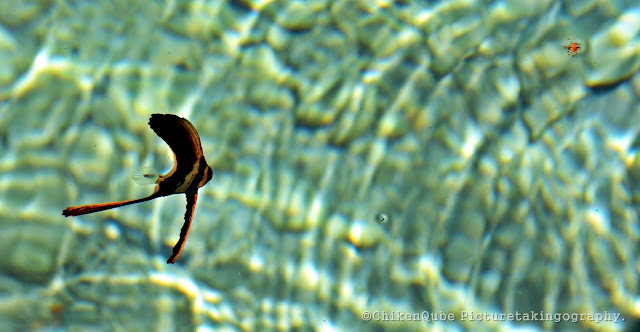San Pedro Island: Unadulterated Island Paradise!
Getting there.
This year alone, I went to the island twice, exactly two weeks apart. One in May and one in June. The road to the island is a two (2) hour drive south, from Tacloban City traversing the Abuyog-Silago Road a national highway cutting through mountains with a scenic view of the lush green forest in the town of Silago. As you reach near the town proper of Hinunangan Municipality, you will see a signage on the left side of the road captioned, "This way to San Pedro and San Pablo Islands". You will have to make a left turn on a gravel road leading to Barangay Canipaan, the jump-off point to the twin set of islands, San Pedro, the larger one, and San Pablo, the smaller one. These two islands are under the sovereignty of the town of Hinunangan. There, you'll have to leave your car, if you brought one, (there's a fenced parking space where the owner asks about Php50.00 for the the day's stay) because you have to go on a 15-minute motorboat ride to get to either of the islands. Getting to the island alone is an amazing journey. I saw fishes jumping out of the water and the spectacular views of the sea and the Hinunangan skyline makes you thank the Lord for providing us with his wonderful creations.
A whole different world just minutes from the mainland.
As we arrived, I immediately jumped off the boat to the knee-deep part of the coral beach. The water was so cool and crystal clear, something we don't see in the hectic urban city of Tacloban. The change of scenery can also be a little overwhelming. In the city, you'd have to work at the office to eat. You have to input data into spreadsheets, make phone calls, and then answer to your boss when you've made mistakes on your monthly report. That's what you have to do to buy milk for your children and provide for your family, well that's the typical scenario. But on the island, it's a whole different world. Here, you'll have to get physical in all you do. You have to fish your own food, fetch your own drinking water from the tubod or spring (thank God they have this on the island), and grow your own rice, yes they have rice fields, Carabaos (water buffalo), cows, the whole lot. Although 50% of the food is taken by boat from the mainland, they also produce rice during rainy seasons. They also have a thriving community mostly comprised of fishermen bringing in the freshest catch of fish and other seafood that is then sold at the other Barangays in mainland Hinunangan. With a population of less than 500 hundred people, everybody definitely knows everybody. They have a complete primary education system from nursery to sixth grade. One local told me that some teachers were from mainland Hinunangan and then married folk from San Pedro Island, a win-win situation, provided that they don't have to cross the sea everyday to work anymore because they now live on the island.
Laid-back lifestyle, with a smile.
Untouched by urban development, the island does not have a constant supply of electricity. What they have are generators that run on diesel. Electricity is only turned on at 6:00 PM until midnight . That's only for charging cellphones, rechargeable lights, and for some, to catch up on the prime time television shows aired through satellite TV. Some have solar power electricity that suffices their lighting needs throughout the night. Some have transistor radios powered by batteries to keep up with the news. The pace here though, is a bit slower. Because when fishermen are done for the day, maybe at noontime, they virtually have nothing else to do. To get around the island faster, you can do it with a bicycle. As I roamed around the island, what I saw were groups of islanders seated around tables drinking tuba (a type of coconut wine famous in the Visayas region), children frolicking around, and some elderly folk sitting on a porch just having a relaxing day with a view of the white sand beach and hearing the soothing sound of the birds chirping and some waves lightly crashing on the shore. This sight alone made me jealous of the life they have on the island, because even though they don't have the things that we're used to in the city, like electricity, Wi-Fi, automobiles, air-conditioning, and the like, I see contentment in their eyes and joy in their smiles even through the simplicity of the lives they're living.
 |
| Powdery white sand at the beach facing the Pacific. |
Rich marine life equals freshest seafood you can find.
I'm not the type of person who loves to go diving or snorkeling. Heck, I don't even know how to swim. But it would definitely be wrong if I don't say that San Pedro Island have world class dive spots that are abundant with marine life. Coral reefs, colorful fish, crustaceans, sea urchins, clams, mussels, small sharks, you name it. But as for me, rich and diverse marine life means bountiful seafood, and cheap too. The first time I got there, we weren't able to buy fish from the locals because they told us that you have to give them a day's notice to reserve your order. But the second time we went there, a local fisherman told us he had some leftover from his early morning catch and he'd like to sell the variety of fish for Php160.00. The bonus had to be the crayfish, they were calling it lobster but I'm pretty certain it was not. My partner's father stewed some of the fish on lemon grass, tomatoes, and onions, and the crayfish went straight to the grill. Fresh seafood always tastes mildly sweet, and that's what we got. As you sever the crayfish's head, the gap in its head contains juices that you should suck out. It's definitely brimming of cholesterol but it's full of flavor and it is sometimes called the liver of the sea.
 |
| Beautiful fish near the dock at Vista Beach Resort in San Pedro Island. |
 |
| Crayfish. Yum! |
One island, two beaches.
San Pedro Island has a neighbor called San Pablo Island, a smaller but has a taller hill than the former. In San Pedro alone, are two textures of beaches. One side, facing mainland Hinunangan is a beach with crushed corals and pebbles. Although hard to walk on, the pebbles remind us of how rich Philippine marine life is. And with clear waters that don't seem to be disturbed by winds during summer, it looks like it is made of glass. The other side facing the Pacific is different. Powdery white sands reminiscent of flour is what you'll tread on as you walk along the beach facing the ocean. They also have a lagoon called Lelang Lagoon from Facebook page Cabugan Grande/san pedro island that is said to be twelve meters deep in the middle. This gives you two beaches to choose from. Some would bring tents to camp out in the island. For the typical tourist like you and me, the island is teeming with resorts that have huts and cottages that cost around Php200.00 for the day. They also provide abuhan (similar to BBQ grill).
 |
| Still waters. Beach facing mainland Hinunangan and nearby town Silago. |
 |
| Lelang Lagoon facing the Pacific Ocean with pulverized coral sand. |
San Pedro Island, is an escape that'll quench your thirst for nature. An adventure in itself even when it is only two and a half hours away from the bustling city of Tacloban. A refreshing experience that breaks you loose from all the frenzy in life, reconnecting you to your roots, to mother nature, God's marvelous creation, God's breathtaking gift to humanity.
 |
| San Pedro Island, Hinunangan, Southern Leyte (May 23, 2015) |
 |
| My daughter and my loving partner. (June 7, 2015) |









0 comments:
Post a Comment